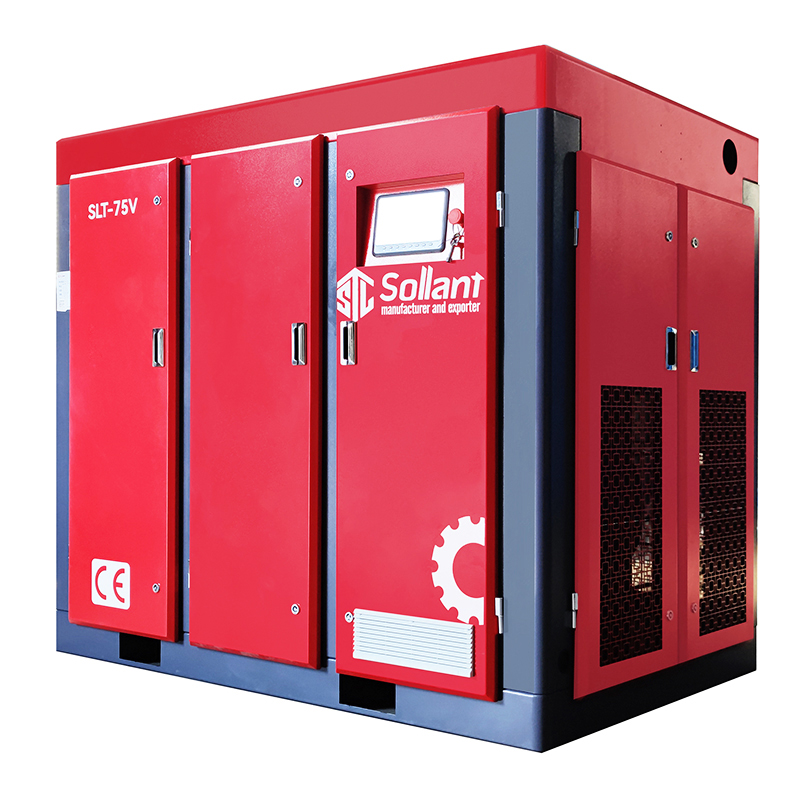
Screw air compressors are crucial in many industries, powering everything from manufacturing processes to energy production and construction equipment. However, these machines are a significant investment, and their performance directly impacts productivity and operational costs. Like any complex machinery, a screw air compressor’s efficiency and lifespan can be heavily influenced by how it is maintained and operated.
By taking proactive steps to maintain your compressor, you can avoid costly repairs, reduce energy consumption, and extend the life of the equipment. This article provides essential tips on how to properly care for screw air compressors, ensuring that they continue to operate efficiently for years to come.
1. Regular Maintenance and Inspection
Scheduled Maintenance
Establishing a routine maintenance schedule is critical for keeping your screw air compressor running smoothly. Compressors are complex machines with many moving parts, and without regular care, small issues can escalate into larger, more expensive problems. Tasks like oil changes, checking the coolant levels, inspecting air filters, and testing safety controls should be done on a regular basis. Following the manufacturer’s recommended maintenance intervals is essential for ensuring the longevity of your compressor.
Component Inspection
Regularly inspecting key components of your compressor can help you catch wear and tear before it becomes a serious issue. Components such as bearings, valves, belts, and seals can degrade over time, and if left unchecked, they can lead to breakdowns or performance inefficiencies. Early detection of issues allows for timely repairs and can prevent costly downtime.
2. Proper Lubrication and Oil Management
Using the Right Lubricant
Oil plays a critical role in the function of screw air compressors by reducing friction between moving parts, preventing corrosion, and helping cool the system. Always use the correct type of oil specified by the manufacturer for the operating conditions. Using subpar or incorrect lubricants can lead to increased friction, wear, and overheating, all of which reduce the lifespan of the compressor.
Changing Oil Regularly
The oil in your compressor degrades over time, losing its ability to lubricate effectively. Regular oil changes are essential to prevent premature wear of the internal components. Depending on the compressor model and usage, oil should be changed at intervals recommended by the manufacturer. In addition to replacing the oil, make sure to check the oil level regularly and top it up if necessary to maintain optimal performance.
Oil Filter Replacement
The oil filter removes contaminants from the oil, ensuring that it remains clean and effective. Over time, oil filters can become clogged with debris and particles, which can reduce the efficiency of the oil circulation system and lead to engine wear. Replacing the oil filter at the recommended intervals is just as important as changing the oil itself.
3. Avoiding Overheating
Monitor Operating Temperature
Screw air compressors generate heat during operation, and excessive heat can lead to a decrease in efficiency and potential damage to internal components. It is important to monitor the compressor’s operating temperature regularly to ensure it is within the manufacturer’s recommended range. If the compressor is running too hot, it can cause damage to critical parts, such as the motor or the screw element.
Ensure Proper Airflow
Proper ventilation is essential for keeping the compressor cool. Inadequate airflow can lead to overheating and premature wear. Be sure to position your compressor in a well-ventilated area where the air can circulate freely. Clean or replace the air filters regularly to avoid blockages, and check for obstructions around the compressor’s cooling fans or heat exchangers. This will ensure that the compressor runs at an optimal temperature, preventing damage caused by excessive heat.
4. Manage Air Quality and Prevent Contamination
Air Filtration
Clean air is vital for the health of your screw air compressor. Contaminants like dust, dirt, and debris can enter the system and cause damage to internal components, leading to premature failure. High-quality air filters are essential for keeping contaminants at bay. Make sure to inspect and replace the air filters on a regular basis, especially in environments with heavy dust or pollution.
Use of Moisture Separators
Moisture in compressed air can lead to corrosion of internal components and damage to downstream equipment. Installing moisture separators in your system can help eliminate water vapor from the compressed air before it reaches the compressor’s internal parts. Using a dryer system, such as a refrigerated or desiccant dryer, can further protect the compressor and downstream machinery by keeping the air dry and contaminant-free.
5. Proper Installation and Environment
Correct Placement of Compressor
The location of your compressor plays a significant role in its performance and lifespan. Install the compressor in a dry, clean, and well-ventilated area. Avoid areas with extreme temperatures or excessive moisture, as these conditions can affect the compressor’s internal components and efficiency. The compressor should also be placed away from direct heat sources or other equipment that might cause overheating.
Vibration Reduction
Excessive vibration can cause mechanical stress on the compressor, leading to premature wear and damage. To reduce vibration, install the compressor on a stable surface and consider using anti-vibration mounts or pads. Ensuring that the compressor is properly mounted and balanced will prevent unnecessary strain on the system, improving its longevity.
6. Regular Monitoring and Performance Tracking
Use of Monitoring Systems
Implementing real-time monitoring systems can significantly extend the life of your screw air compressor. These systems track critical parameters such as pressure, temperature, oil levels, and energy consumption, providing valuable data for optimizing performance. Monitoring these metrics allows you to detect potential problems early, so you can address them before they lead to major failures.
Performance Audits
Regular performance audits can help you assess the overall health of the compressor and identify areas for improvement. By conducting regular checks on energy consumption, operating hours, and output efficiency, you can ensure that your compressor is operating at peak performance. Performance audits help to uncover hidden issues, reduce downtime, and maintain energy efficiency.
7. Proper Training for Operators
Training and Education
The proper training of operators is essential for the longevity of your screw air compressor. Operators should be trained on how to handle the equipment correctly, including proper startup and shutdown procedures, as well as how to monitor and maintain optimal operating conditions. An operator’s negligence or misuse can lead to unnecessary strain on the compressor, reducing its lifespan.
Operational Best Practices
Encourage your operators to follow best practices when using the compressor. This includes avoiding unnecessary running time, turning off the compressor during idle periods, and ensuring that the compressor is not overworked by exceeding its capacity. Operators should also be trained to recognize warning signs of impending failure, such as unusual noises or abnormal vibrations, and report them immediately.
8. Use of Advanced Technology and Upgrades
Incorporating Energy-Efficient Features
Modern screw air compressors are often equipped with advanced technologies that improve efficiency and reduce wear. For example, compressors with Variable Speed Drive (VSD) systems adjust their speed based on the air demand, reducing energy consumption and minimizing stress on the compressor components. Upgrading to newer, more efficient models can significantly extend the life of your equipment while reducing operational costs.
Upgrading Components
Over time, certain components of the compressor, such as valves, seals, and filters, may wear out. Replacing these parts with higher-quality or more efficient components can help improve the overall performance of the system and reduce the strain on the compressor. Regularly upgrading components or replacing worn-out parts ensures that the compressor continues to operate at peak efficiency.
9. Addressing Load and Demand Properly
Matching Air Demand to Compressor Capacity
It is crucial to match the compressor’s capacity to the air demand of your system. Running the compressor at full capacity when less air is needed leads to unnecessary wear and higher energy consumption. On the other hand, undersizing the compressor can cause it to run continuously at maximum output, also increasing wear. Properly sizing the compressor and adjusting its output according to real-time demand helps reduce unnecessary strain and extends the life of the machine.
Using Multiple Compressors for Variable Demand
For operations with fluctuating air demand, using multiple smaller compressors rather than one large compressor can improve efficiency. Smaller compressors can be turned on and off as needed, preventing the system from running continuously at partial load. This load-matching strategy helps ensure that the compressors are only running when needed, which reduces wear and energy consumption.
10. Reduce Compressor Cycles and Unnecessary Run Time
Load/Unload Cycles
Excessive cycling between load and unload modes can put unnecessary strain on the compressor and reduce its lifespan. Implementing load/unload controls can help optimize compressor cycles by preventing the system from constantly starting and stopping. These controls ensure that the compressor only operates when air demand requires it.
Automated Control Systems
Many modern screw air compressors come with automated control systems that can shut down the compressor during periods of low demand or inactivity. These systems prevent the compressor from running unnecessarily, reducing wear and tear and improving energy efficiency.
Conclusion
Prolonging the life of your screw air compressor requires a combination of proactive maintenance, proper operation, and regular monitoring. By following the tips outlined above—from performing routine maintenance and using the right lubricants to managing air quality and ensuring proper installation—you can significantly extend the lifespan of your compressor, reduce downtime, and avoid costly repairs. Regular care and attention to your compressor’s needs will pay off in the long run, ensuring that your investment continues to deliver reliable, efficient performance for years to come.


